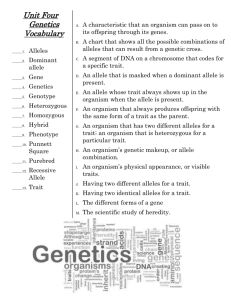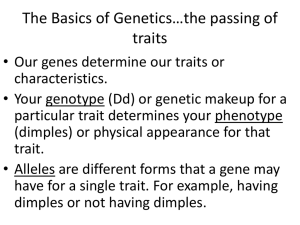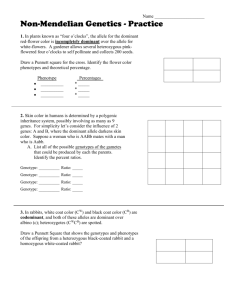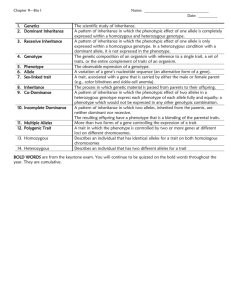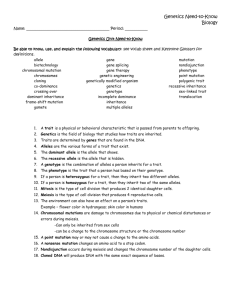Genetics SG
advertisement
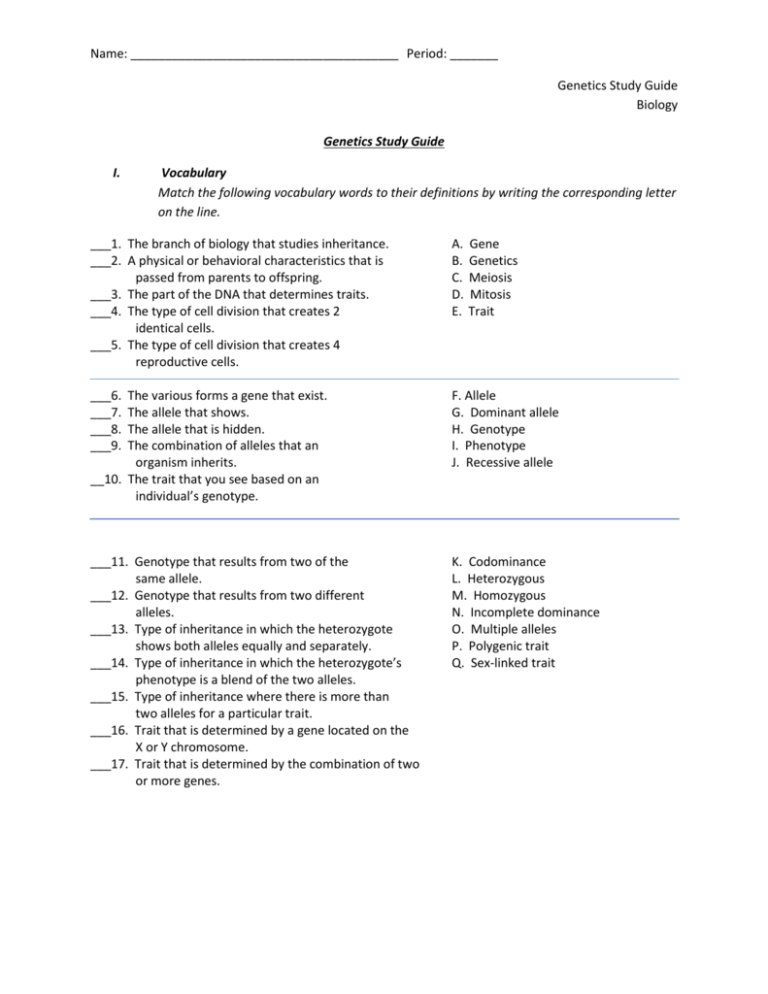
Name: _______________________________________ Period: _______ Genetics Study Guide Biology Genetics Study Guide I. Vocabulary Match the following vocabulary words to their definitions by writing the corresponding letter on the line. ___1. The branch of biology that studies inheritance. ___2. A physical or behavioral characteristics that is passed from parents to offspring. ___3. The part of the DNA that determines traits. ___4. The type of cell division that creates 2 identical cells. ___5. The type of cell division that creates 4 reproductive cells. A. B. C. D. E. Gene Genetics Meiosis Mitosis Trait ___6. ___7. ___8. ___9. The various forms a gene that exist. The allele that shows. The allele that is hidden. The combination of alleles that an organism inherits. __10. The trait that you see based on an individual’s genotype. F. Allele G. Dominant allele H. Genotype I. Phenotype J. Recessive allele ___11. Genotype that results from two of the same allele. ___12. Genotype that results from two different alleles. ___13. Type of inheritance in which the heterozygote shows both alleles equally and separately. ___14. Type of inheritance in which the heterozygote’s phenotype is a blend of the two alleles. ___15. Type of inheritance where there is more than two alleles for a particular trait. ___16. Trait that is determined by a gene located on the X or Y chromosome. ___17. Trait that is determined by the combination of two or more genes. K. Codominance L. Heterozygous M. Homozygous N. Incomplete dominance O. Multiple alleles P. Polygenic trait Q. Sex-linked trait Name: _______________________________________ Period: _______ Genetics Study Guide Biology II. Genetic Cross Problems Solve the following genetic crosses by completing Punnett squares and answering the questions. You must show all work! Simple Punnett Squares 18. In humans, brown eyes (B) are dominant to blue eyes (b). If you cross a blue-eyed female with a heterozygous brown-eyed man, what is the probability they will have a child with blue eyes? 19. In cats, a fluffy tail (F) is dominant to a smooth tail (f). If a heterozygous fluffy-tailed cat is crossed with a homozygous fluffy-tailed cat, what is the probability they will have an offspring with a smooth tail? Complex Genetic Problems 20. In chickens, the alleles for black (B) and white (W) feathers are co-dominant. The heterozygous chickens are checkered. If a checkered chicken is crossed with a black chicken, what is the probability they will have an offspring that is white? Name: _______________________________________ Period: _______ Genetics Study Guide Biology 21. In raccoons, the thickness of the rings on the tail is inherited by incomplete dominance. Raccoons can have thick-ringed tailed (TT); skinny-ringed tails (SS) or medium-ringed tails (TS). If two mediumringed raccoons are crossed, what is the probability that their offspring will have skinny-ringed tails? 22. In humans, color-blindness is a trait inherited on the X chromosome. If a man who is color-blind is crossed with a woman who is heterozygous for color-blindness, what is the probability that they will have a child who is colorblind? 23. The height of a giraffe is determined by a combination of 5 genes. The giraffe will begin as 4 m in height and gain 0.5 m for each dominant allele it inherits. If a giraffe is GgGGGgggGg, how tall will that giraffe be? 24. Explain why traits such as skin color, weight, height, and eye color are found in such wide varieties. Name: _______________________________________ Period: _______ Genetics Study Guide Biology 25. Explain why you can’t always just use a Punnett square to determine the outcome of a particular cross.




